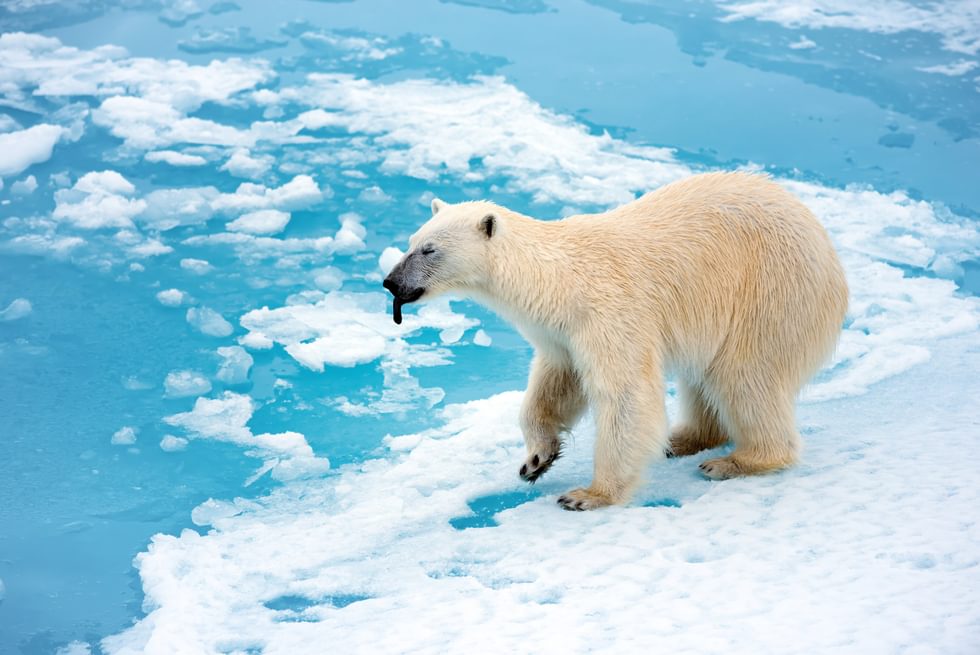The Unbuilt Environments of Arctic Offshore Oil and Gas Development
From the Series: Arctic Abstractive Industry
From the Series: Arctic Abstractive Industry

The image of the future Arctic as a booming oil and gas province has become one of the strongest representations of the region (Powell and Dodds 2014; Steinberg, Tasch, and Gerhardt 2015). A key number behind these prognoses and geopolitical imaginaries is the widely cited U.S. Geological Survey estimate that 25 percent of the world’s undiscovered petroleum reserves are located in the Arctic. The shale gas revolution in the United States and the dramatic drop in oil prices since late 2014 have resulted in high-cost Arctic oil and gas prospects being shelved (Claes and Moe 2014). This includes the Shtokman field in the Barents Sea, which is addressed in this brief essay, and the recent cessation of Shell’s exploratory activities in the Chukchi Sea in the summer of 2015.
These projects—proposed but unrealized—and the regulatory, stakeholder/participatory, business, and scientific processes that surround them can be seen as unbuilt environments (see Oberdeck 2006). Jonathan Peyton (2011) explored this concept in his study of a planned, but not implemented, hydroelectric dam project in British Columbia. Peyton documents the longstanding discursive consequences for how the watershed landscape is framed and understood, as well as the material traces left by exploratory infrastructure and by increased scientific and expert engagement in the region.
Arctic landscapes of expectation (and disappointment) include the possibility of petroleum development in the Barents Sea that promised a new chapter in the economic geography of northwest Russia. The Shtokman gas field, located some 600 kilometers north of the shores of the Kola Peninsula, is one of the world’s largest natural gas fields. In 2005, cooperation agreements to develop this field were signed by Russia, Norway, and France, with Gazprom at the forefront. This triggered an avalanche of bids for field development (Claes and Moe 2014). What ensued might be described as a beauty pageant, with companies seeking to present their competence (including in corporate social responsibility [CSR] and local relations), financing, and willingness to accept bargaining downwards on contract terms. Eventually, Statoil and Total joined a consortium with Gazprom called the Shtokman Development AG in 2008. However, the shareholder agreement expired in 2012 and exploration never got off the ground (Claes and Moe 2014).
Despite the project remaining unrealized, exploratory interviews (Wilson Rowe, forthcoming) showed that a cross-section of the public in Murmansk nevertheless possessed well-developed expectations and perceptions of the oil and gas companies that had jockeyed for positions around the Shtokman gas field. Unless we take into account an Arctic landscape strewn with such unbuilt ghost projects, we may be poorly positioned for understanding the dispositions, policy trajectories, political processes, and expectations that Arctic residents bring to future debates about circumpolar economic and social development.
In conceiving of an unbuilt environment research agenda in the Arctic, it is important to remember that stakeholders use their built environment and historical experience in considering and valuing possible/future/unbuilt environments as well. Although offshore oil and gas development—like the Shtokman field that created so much buzz in Murmansk— involves new technologies and novel sets of international companies, the Russian Arctic remains the most industrialized and urbanized part of the Arctic (Huskey, Mӓenpӓӓ, and Pelyasov 2014). As interviewees were asked to consider whether the international parade of oil and gas companies involved in the Shtokman field had met their expectations, they were reluctant to engage with the concept of CSR that the companies had brought with them. Rather, interviewees warmly referred to a gold standard of past and present employee benefits set by the industrial complexes of the Soviet period: entertainment and celebrations, travel, pensioner housing, specialized medical care, education, and other family services.
It is also important to consider how local, international, and regional standards and discourses brought in by media, international companies, and circumpolar cross-border interactions combine to shape these unbuilt landscapes in novel ways. The partially overlapping—yet still distinct—understandings of key concepts like CSR and sustainable development that are evident from the interviews suggest that Arctic policymakers, corporate practitioners, and academics must remain attuned to the contested reach of concepts that seem so widely accepted and understood in international Arctic settings. As Arctic cooperation continues to expand, most recently to economic issues via the newly established Arctic Economic Council, attention to the limits of shared ideas and practices and the abiding significance of built and unbuilt local environments remains essential.
Claes, Dag Harald, and Arild Moe. 2014. “Arctic Petroleum Resources in a Regional and Global Perspective.” In Geopolitics and Security in the Arctic: Regional Dynamics in a Global World, edited by Rolf Tamnes and Kristine Offerdal, 97–120. Oxford: Routledge.
Huskey, Lee, Ilmo Mӓenpӓӓ, and Alexander Pelyasov. 2014. “Economic Systems.” In Arctic Human Development Report: Regional Processes and Global Linkages, edited by Joan Nymand Larsen and Gail Fondahl, 151–82. Copenhagen: Norden.
Oberdeck, Kathryn T. 2006. “Archives of the Unbuilt Environment: Documents and Discourses of Imagined Space in Twentieth-Century Kohler, Wisconsin.” In Archive Stories: Facts, Fictions and the Writing of History, edited by Antoinette Burton, 251–74. Durham, N.C.: Duke University Press.
Peyton, Jonathan. 2011. “Corporate Ecology: BC Hydro’s Stikine-Iskut Project and the Unbuilt Environment.” Journal of Historical Geography 37, no. 3: 358–69.
Powell, Richard C., and Klaus Dodds, eds. 2014. Polar Geopolitics? Knowledges, Legal Regimes, and Resources. Cheltenham, U.K.: Edward Elgar.
Steinberg, Philip E., Jeremy Tasch, and Hannes Gerhardt. 2015. Contesting the Arctic: Politics and Imaginaries in the Circumpolar North. London: I.B. Tauris.
Wilson Rowe, Elana. Forthcoming. “Promises, Promises: Murmansk and the Unbuilt Petroleum Environment.” Oslo: Norwegian Institute of International Affairs.